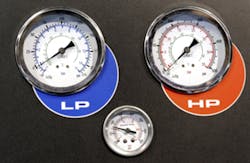Low-pressure and low-energy membranes in commercial systems
Low-pressure and low-energy are terms used interchangeably for low pressure elements because pressure and energy are interrelated in membrane technology. According to Bill Loyd, a technical service specialist for residential and commercial RO elements at Dow Water and Process Solutions, the trade-off comes with flow and rejection, which work inversely with one another in reverse osmosis technology. For commercial and industrial applications that don’t require maximum permeate quality, LE/LP elements can offer a host of benefits. Users can choose to run these membranes at a low pressure to achieve energy savings, or operate them at the same pressure to increase permeate flow and achieve other benefits.
One of the major benefits of LE/LP membranes is cost savings. A low pressure membrane can reduce feed pressure requirements, saving money because a less expensive, lower pressure pump can be used. Lower pressure also reduces operating costs through less energy use to force water through the membrane.
For two examples of how low pressure membranes can save money, read Bill Loyd’s full article here: Taking advantage of low pressure membranes in commercial systems.
Low-pressure membranes are also beneficial because they achieve higher permeate flows on low temperature feed water, sometimes being referred to as “cold water membranes.” Using cold water can significantly impact energy costs as well. See charts and examples for using cold water in an RO system here: Taking advantage of low pressure membranes in commercial systems.
If a LP/LE element is run at standard RO operating pressures to increase permeate flow into an existing system, it can result in excessive flux rates, shortening element life by accelerating the onset of element scaling. LP/LE elements are often used in this manner when a system operator needs to increase water production while avoiding the cost of purchasing and installing an entirely new RO system. An LP/LE membrane can supply extra water without requiring a switch to a higher pressure pump or the addition of more elements.
Find examples of this scenario here: Taking advantage of low pressure membranes in commercial systems.
“Understanding the tradeoffs in terms of permeate quality and element life can help operators determine how best to use them in various commercial applications,” Loyd explains.
